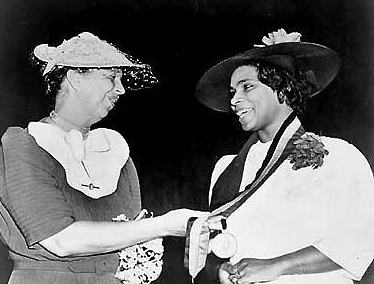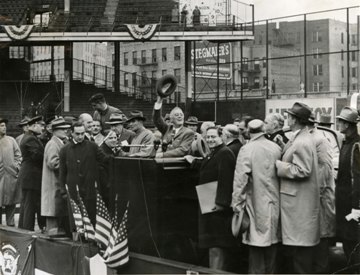|
We’ve managed to catch some of the wonderful Ken Burns documentary on the Roosevelts on Public Television – a great vision of America, as vital as today’s front page.
In the parts we’ve seen, I recalled my slight personal connections to Theodore Roosevelt, Franklin Roosevelt, Eleanor Roosevelt. As a young reporter, I interviewed Theodore Roosevelt’s younger daughter, Ethel Carow Roosevelt Derby, by then in her eighties, in Oyster Bay, Long Island. I almost blew the interview right away by referring to her father as a hunter. He was not a hunter, she snapped; he was a sportsman. (I had seen those heads in the museum.) The documentary refers to him often as a hunter. Mrs. Derby would not be amused. As a five-year-old, in a household that loved Franklin and Eleanor, I was taken to his campaign through New York on a miserable rainy day, Oct. 21, 1944. I recall being on a hillside, watching the motorcade on Grand Central Parkway. The car was open, and his face was pasty white. The web says he told the crowd in Ebbets Field that he had never been there before, but claimed he had grown up a Brooklyn Dodger fan. He died six months later. That romp through the boroughs did not help. Eleanor Roosevelt was a staple in the politics and affection of my family. Later we read books about how she pressured her distant husband into absorbing information about the plight of so many Americans. Two things I have heard about Eleanor Roosevelt lately: When I was working on the Stan Musial biography, I learned that Musial had joined a tour for John F. Kennedy in 1960, which included Angie Dickinson. The actress became a knowledgeable source about that campaign, telling me how she was addressing a crowd in the New York Coliseum on the Saturday before the election: “My big claim to fame is that I was making my speech, and I heard a hush and they wheeled in Mrs. Roosevelt, Eleanor Roosevelt, and I got to say, ‘What I have to say isn’t important’– I almost was finished – ‘Ladies and gentlemen, the great Eleanor Roosevelt,’ and I got to introduce her.” Dickinson’s respect, half a century later, was palpable. I learned something about Mrs. Roosevelt recently while reading a very nice history book – Indomitable Will: Turning Defeat into Victory from Pearl Harbor to Midway, by Charles Kupfer, an associate professor at Penn State Harrisburg. In the first shocking hours after the attack on Pearl Harbor on Dec. 7, 1941, the President assembled advisors and friends in the White House, including Edward R. Murrow, the CBS broadcaster (this was back when networks maintained serious news organizations.) FDR picked the brains of Murrow, who had access to the back rooms of the White House. Eleanor Roosevelt, who had fought for millions of poor people, who had fought for civil rights and women’s rights, cooked some eggs for Murrow. Kupfer’s book had me, right there, on Page 22. The Burns documentary had me as soon as I saw the insecure half-smile of young Eleanor Roosevelt, before she discovered the activist within. Her wise eyes take the measure of a country that has failed its people. She spends her own money to build experimental communities in deepest West Virginia. She sets an example. The camera cannot find too much of her. She reminds us of the men who went to war, the women who went to work, the blacks who wrote letters to the President, asking for help. Her face reflects the country many of us thought we were, or could have become. As I wrote this, I flashed on something else about the Burns documentary: Elizabeth Warren reminds me of Eleanor Roosevelt.
Sam Toperoff
9/19/2014 07:17:54 am
Just a superb article, George. Glad I know you.
George Vecsey
9/19/2014 09:00:33 am
merci, mon ami..G
Thor A. Larsen
9/19/2014 07:19:55 am
George Vecsey
9/19/2014 08:55:58 am
Thor, great to hear from you. I didn't know Val-Kill was public...went to Hyde Park decades ago, and have it in my mind to go back....
Craig N. Oren
9/19/2014 12:56:37 pm
thanks to the descendants of Vice-President Henry Wallace, the house and environs at Hyde Park look much improved -- maybe improved from what you remember. I know it's a long drive up the Hudson, but it's worth while, IMHO.
Jeff Geller
9/19/2014 08:26:25 am
One of the disagreements I had with the now former girlfriend was about the legacy of FDR. I advocated that he saved the nation. . . period. She was of the opinion that he did not do enough to save the victims of the Holocaust.
George Vecsey
9/19/2014 08:59:54 am
Thank you...I have not seen all the segments, so cannot comment on that end, but I know that point of view is out there. So is the view that FDR was really Jewish and really Communist...maybe even really Kenyan. From what I read, the whole world could have done better....Thanks for your thoughtful note. GV
Michael Green
9/20/2014 09:42:39 am
I'm a history professor, so I talk a bit in class about the Roosevelts. I've enjoyed the documentary a great deal, despite George Will's presence (and not merely because I disagree with his politics, but because if Burns wanted an FDR critic, there were historians he could have found who are more knowledgeable about what's going on). Anyway, I did the oral history of a longtime Nevada attorney/politician, Ralph Denton, who ran the Senate elevator as a page. He said that he got to hold the elevator for Mrs. Roosevelt and screwed up something, and the secret service agent was chewing him out when she put her hand on the agent's shoulder and told him to stop that. What stayed with Ralph, though, was that she walked through the kitchen area and all of the workers were African American. They all stood for her. And she greeted every one of them.
George Vecsey
9/20/2014 10:20:22 am
That is lovely. Thanks, GV 9/20/2014 09:51:57 am
George
George Vecsey
9/20/2014 10:31:13 am
Alan, great story. I knew a lot of Jews had emigrated to Shanghai....the govt recently moved all the headstones....Never heard about Japan. Quite a daring move by Sugihara. Thanks for the note. GV
Ed Martin
9/20/2014 03:33:23 pm
George, what a wonderful column and what wonderful responses. Peggy and I have been glued to the PBS station and just thoroughly appreciating the series, the history, the entertainment, the inspiration. The complex human relationships with light shown on them were often remarkable.
George Vecsey
9/21/2014 01:52:05 am
Ed, did not know about the ER show. What does she think of the Streep accent? It sounds like a Long Island Lockjaw-Hyde Park amalgam
Ed Martin
9/21/2014 11:03:11 am
Peggy says, "fuggetaboudit" During the show, Peggy said quietly "she doesn't have the accent--I did better than that." She was right,and we find Meryl Streep almost always excellent. Comments are closed.
|
Categories
All
|











